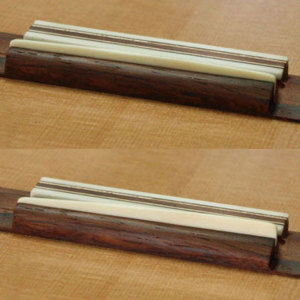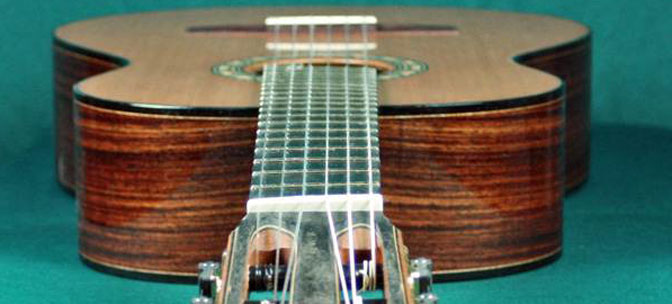How do you give the bass-E string enough room to vibrate when you’re playing with gusto but at the same time keep the treble-E string close enough to the fingerboard to let you play those lightning-fast passages?
So why does the bass-E string need more vibrating room than the treble-E string anyway? It’s because the “string excursion”—the distance the string needs to travel when vibrating—is greater with the bass-E string, making it more susceptible to adjacent-fret buzzing. The bass-E string should be about 1mm higher at the 12f than the treble-E string to optimally overcome this.
In the picture above, thanks especially to the photographic parallax which exaggerates the effect, you can see clearly how the fingerboard edge on one of my guitars falls off toward the 19f on the bass side—the twist in the plane—to raise the bass-E string. Notice, however, that the treble edge falls off toward the nut as well. This is to distribute some of the overall twist-plane to the treble side in order to reduce the amount of fingerboard thinning between the 12f and 19f on the bass side. Ramirez is noted for use of the bass-side twist-plane (which is where I got the idea years ago). I have encountered one guitar in my career in recent years, made in Germany by a luthier whose name I cannot recall, that had the twist-plane all on the treble side. As far as I know, my guitars are the only ones made anywhere that use a combination bass/treble twist-plane.
If a builder doesn’t use the twist-plane concept, there are only two other alternatives: settle for inadequate Eb-Et differential (or none at all), or; make the saddle higher on the bass side. There’s just one problem with raising the saddle: because of the geometry of guitar construction, to get a full 1mm Et-Eb differential, you must make the saddle 2mm higher on the bass side. This is not just visually uncomfortable, it produces unacceptable torque stress on the bridge. If my guitars were to dispense with the twist-plane fingerboard but retain the 1mm Et/Eb differential, the comparison would look like this—

(If you Ctrl-Click the image above, you can open it in a separate window for more detail. Click anywhere on the image to zoom in for maximum detail.)

